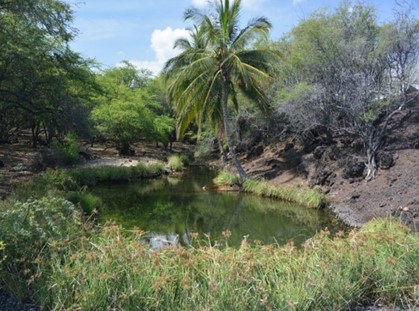Anchialine pools in Hawaii are culturally important brackish ecosystems with an underground connection to the ocean and are threatened by sea level rise. An NCCOS-sponsored study developed methods to assess potential impacts to anchialine pools from future coastal flooding, using the big island of Hawaii as a case study.

Anchialine pool at Waiaʿelepī in West Hawaii. Credit:Barbara Seidel, The Nature Conservancy Hawaii.
Anchialine pools are brackish, tidally influenced bodies of water with a subterranean connection to the ocean. The word “anchialine” comes from the Greek word ankialos, meaning “near the sea.” Anchialine ecosystems form in limestone or volcanic rock (Stubbs, 2019).
These ecosystems can support fisheries, cultural practices, and tourism, and are threatened by climate change, invasive species, and other factors. In the coming decades, some anchialine pools will be lost due to rising sea levels, while others will merge to form larger pools.
Despite a worldwide distribution, anchialine ecosystems and biota have been largely omitted from sea level rise risk assessments for coastal ecosystems.
The goal of this study was to develop methods to assess potential impacts to anchialine pools from future coastal flooding. Flood predictions incorporated pool surveys, groundwater-level measurements, and statistical analysis of flood frequencies observed in tide gauges combined with regional scenario-based projections of future sea levels. High-resolution geospatial models were then generated to predict anchialine pool location, density, and risk factors for the next 60 years.
The study found that along 40 km of coastline, up to 80 percent of current anchialine pools will be lost by 2080 as pools merge with ocean habitats; however, as groundwater flooding occurs more frequently and new habitats are created inland, the total pool counts will rise from 509 in 2018 to 1,000 by 2080. As a result of extreme water-level events, non-native fishes are predicted to disperse into 42 percent of pools by 2030. Based on current conditions, development of cesspool risks are quite low for anchialine pools in the study area.
Outcomes from this study are guiding conservation actions, including habitat restoration, non-native fish removal, and development planning decisions in coastal areas. This study illustrates methods that can be used to assess the effects of SLR on anchialine pool habitats worldwide.
This study was supported by the NCCOS Ecological Effects of Sea Level Rise project Sea-Level Rise Modeling as a Catalyst for Effective Ecological Management in West Hawai‘i led by The Nature Conservancy of Hawaii and partner University of California Berkeley,
The area of the study is in the NOAA West Hawai'i Habitat Focus Area. The study was published in the journal Aquatic Conservation: Marine and Freshwater Ecosystems.

Conceptual model of anchialine pool dynamics. Credit: Kyra, Grade 5, Manoa Elementary School, HI
 Official websites use .gov
A .gov website belongs to an official government organization in the United States.
Official websites use .gov
A .gov website belongs to an official government organization in the United States. Secure .gov websites use HTTPS
A lock or https:// means you’ve safely connected to the .gov website. Share sensitive information only on official, secure websites.
Secure .gov websites use HTTPS
A lock or https:// means you’ve safely connected to the .gov website. Share sensitive information only on official, secure websites.